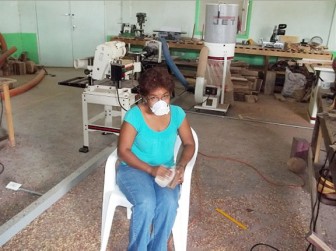Lack of financing and an effective local lobby as well as the high cost of taking advantage of potentially lucrative overseas markets continue to inhibit the local craft industry both as a source of secure employment for Guyanese and as a significant money-earner for the economy, according to Managing Director of Amazon Authentics, Irene Bacchus-Holder.
Speaking with Stabroek Business earlier this week, Bacchus-Holder, who has recently undertaken marketing-related visits to several countries in Europe said the underexposure of Guyanese art and craft to the international market had less to do with quality and more to do with the fact the effective international marketing was a “high-cost” venture which, in most cases, Guyanese in the industry cannot afford. “My own experience of going to these overseas craft shows and exhibitions tells me that it takes time for the market to grow accustomed to seeing your work. Not much is likely to happen for you if you attend the occasional craft show in Europe. Buyers have got to grow accustomed to your work, its uniqueness and its quality,” she said.

Bacchus-Holder whose ornamental and hand-crafted jewellery and artefacts are fashioned mostly from a variety of species of local woods told Stabroek Business that the success creative artists from other countries had secured on the international market took “years – sometimes up to five years – of investing in attending some of the major craft shows and exhibitions around the world. The market is there but there are costs associated with reaching that market,” she said.
And according to Bacchus-Holder local craftsmen and women cannot be left on their own to develop the local industry. “We are talking about people, many of whom have remained at the cottage industry stage and who, because of limited finances, are unlikely to move from that stage. The commercial banks have not always been helpful because of the problem of risk associated with investing money in uncertain projects. Even if the quality of your work is good enough, your business plan has to reflect potential access to markets that provide a reasonable assurance of a return. That is one of the difficulties facing local craftspeople,” Bacchus said.
Bacchus-Holder, a former treasurer of the Guyana Art and Craft Producers Association (GACPA) and one of the more frequent local travellers to international art and craft shows and exhibitions said her efforts to have her own work make inroads on the international market have taught her a great deal about the nature of the industry. “The international art and craft industry, apart from being a way of promoting cultures and countries is also a serious market place. People go there looking for items that at least appear to be worth their investment. They also look for reliable suppliers – people who can produce what they want regularly, reliably and in the kinds of quantities that make business sense for them.”
Accordingly, Bacchus-Holder said, if the local art and craft industry is to grow, ways have to be found to transform cottage industries in sound businesses with reliable production streams “that understand what it requires “to take full advantage of the international market.”
Bacchus-Holder acknowledged that some help had been forthcoming from government through the Guyana Office for Investment (Go Invest) in supporting local representation at overseas trade fairs. Additionally, she alluded to the move by government to allocate a building to the GACPA for use as a secretariat. “Those are worthwhile gestures which we acknowledge but unfortunately it is not enough. The fact that art and craft producers have limited finances means that they need more official help if what they do is to help market Guyana abroad.”
Meanwhile, according to Bacchus-Holder, such opportunities as usually arise for the marketing of Guyanese art and craft overseas are frequently undermined by a banking system that is out of step with payment systems in those countries where the markets are the most lucrative. “It takes three months to facilitate the clearance of foreign cheques with the local banking system and unfortunately people who want to do business with local craftspeople have no wish to do business that way. They make like your products and may want to buy them but they are not prepared to wait that long to receive their goods.”
And according to Bacchus-Holder, local craftspeople are also likely to be confronted with the growing problem of “copying,” a practice which she said had reared its head during the 2007 Cricket World Cup. Attempts to take advantage of foreign visitors to the Caribbean for that event to market craft from the region had been marred by the importation into the region of large volumes of copied souvenirs which were being sold as products from the region.
In the case of Guyana, some local business houses imported large quantities of relatively cheap copied artifacts and apparel for sale on the local market. “We are vulnerable to this problem because, given our economic circumstances, a local exhibitor may be approached by a buyer at an international fair with an offer to acquire all of the items available… They are not interested in a continuous supply. Their interest is in making quantities of copies and marketing those copies as though they were original works made in Guyana. Most of our craft producers know little about how to protect their work from copying.”










